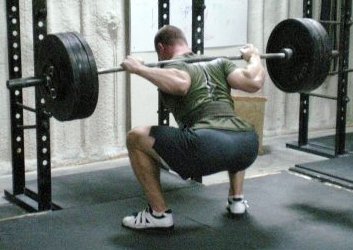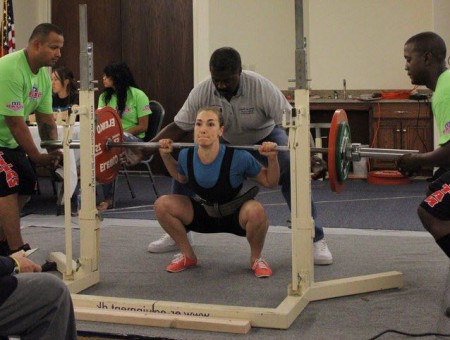My travels have led me to many gyms ranging from performance centers for special operations personnel to CrossFit gyms, from storage containers to globo gyms. There is a constant in all of these facilities: inefficiency.
Though I’ve rehashed topics like this ad nauseam in the past (see additional links at end), it’s always good to revisit them and put them back in the fore front of readers’ minds.
The squat is the most important exercise anyone can do for any goal.
Want to get stronger and/or bigger? You’ll need to squat since it strengthens the legs and hips through a full range of motion while the trunk isometrically maintains position; it’s a full body exercise. And since it’s training the majority of the musculature in the body, it garners a systemic (i.e. large scale hormonal) response in order to heal the damage done from an effective squat workout. This systemic response is what augments any other lifting you’ve done in the same training session and is the adaptive stress that spurns recovery and strength gain.
Want to lose body fat? The systemic stress response from squatting means hormones are working in overdrive to recover — a process that requires calories and stimulates muscle repair and growth. By using calories and growing new muscle — and doing this regularly with consistent training — the body is in a hormonal environment that facilitates body fat loss. To this day I’ve never had a female trainee not lose body fat on a strength training program.
Want to get faster? The squat takes the hips through a full range of motion and accentuates hip extension — the fundamental athletic movement. The squat also inherently involves a stretch reflex out of the bottom; the musculature about the hips and thighs moves into a position of tension and quickly shortens, or contracts, to explode out of the bottom. The squat perfectly prepares the related musculature for speed and power training as well as teaching the trunk how to stabilize the spine and hips to efficiently transmit force while moving (an important aspect of sprinting). The act of improving absolute strength will decrease the difficulty of repetitive movement, resulting in the capacity for higher or faster rates of work.
By regularly loading the muscles, tendons, ligaments, and bones with a full-body movement like the squat through a full range of motion, these structures adapt to be stronger, more dense, and ultimately less likely to be injured.
However, in order for all of this to be the case, the squat needs to be performed efficiently with adequate mobility. And the first god damn step is squatting all of the way down — a point in which the hip capsule (acetabulum) is below the top of the knee (or patella). If you’re reading 70’s Big, then you most likely squat to full depth on each rep, but statistically speaking there are a few of you who don’t.
As I’ve said before: Every time you don’t squat to depth, I pour a beer down the drain. And I HATE wasting beer.
For the sake of the gods, let’s make this simple: a cue to help reach depth on any squat type is “shove your knees out”. Sure, there is a lot of other things we could focus on like stance width, toe angle, torso alignment, breathing techniques, chest positioning, eye gaze, and so on, but anyone can squat to depth if they shove their knees out. The rest will figure itself out.
Shoving the knees out externally rotates the hips to point the femur out away from the mid-line. It helps clear the femur from impinging on front of the hip capsule and surrounding tissue and allows for more hip flexion, AKA depth. It also helps create the “torque” at the hip that Kelly Starrett frequently talks about and results in distributing the force application across the hips and thighs efficiently (more on that here). It can help if the “knees out” cue is originating at the outside of the hips (imagine a twisting motion on the lateral hip that results in the knees out).
Since I’m preaching to the choir about squatting to depth, it’s up to all of you to help your friends do the same. If you frequent a gym and establish relationships, then it is your honor-bound duty as a lifter to help them. Don’t be a dick and just ask them if they mind if you say something about their squat — most people are very open to this because they secretly have no fucking idea what they are doing and ultimately have six pounds of anxiety building in their chest. Don’t over-complicate the matter — make simple and quick adjustments and give them a single cue before sending them back to the bar. For example: narrow up the stance, change the toe angle, then just have them think knees out — the first two are passive cues that they don’t have to think about and the last is the only active cue they worry about.
Whether you’re a half squat abuser or you are guilty by proxy, spread the word that the only way to squat is to full depth.
More 70’s Big articles on squatting:
A Half Squat Is Not A Squat
Squat All of the Way Down
Low Bar vs High Bar Squatting



Sweet mother of pearl! I’m glad you’re back!
Great to have an article by you again. I’ve always enjoyed the technical but straightforward and easy to understand style of your writing.
As always, good stuff! I got a little question. The 455 for 5×5, I cant tell if you’re full low bar or high bar or a hybrid of the two, but I see that you are rocking Olympic shoes. If it is a low bar, how do you like the Olympic shoes for it? I have an extreme thoracic kyphotic curve due to compression fractures, and i have used them in low bar but I’m not completely versed in the should or should nots of Olympic shoes for low bar. Many thanks for the advise.
Not Justin, but that is definitely a low-bar squat in the picture. I personally use Olympic shoes for both high-bar and low bar squats. My sense is that the raised heel is more important for high-bar or front squats where your knees come forward more and the bottom position is deeper. For low-bar squat with a wider stance, I think it matters less, and you can be fine with either Olympic shoes or flatter soled shoes with a firm sole like Chucks, Sambas, minimalist “barefoot” shoes, etc. I don’t know what the implications of your back condition would be for heel vs. flat shoes on the low-bar squat, but I would just try both and see what feels better.
Yeah I always use them for HBBS, FS, C & J, and Snatch. But from what I’ve been taught, in LBBS you need to keep vertical shins with knees out. But who really knows anymore! I just don’t want to jack my knees up!
The heel doesn’t necessarily force your knees to go forward on a LBBS. I have shit ankle mobility, so even with the heel my shins are pretty easy to keep vertical anyways.
The solid heel and metatarsal strap are easily worth it though for low bar. So much more stability compared to chucks or vibrams etc.
Awesome post! Glad to see Justin back posting.
Regarding the “knees out” queue. I’ve always thought of it as actually pushing my knee joints outward. But now that I’ve read what you’ve written I’m thinking that I’m visually and mechanically doing it wrong. Should I think of it as pushing my knee’s outward, or think of it as if I’m rotating my femurs out at the hip causing my knees to go out?
Hopefully I’m stating that right.
Thanks,
~Chris
When I unrack the bar, I twist my legs (ie femurs) externally. Activates the glutes and quads really well, and causes my ankles and feet to be in a stronger arched position (if I don’t twist at the top, my ankles collapse in). In addition, on the way down and up, I try to keep the knees tracking over the pinky toes. This has helped with my form, but I’m still a lightweight.
Hey Justin. What is your opinion on using a pair of modified heel-less Oly shoes for low bar squats like Mike Tuchscherer? I love a heel for high bar but it’s never felt right for low bar, and I hate squatting in Chucks.
After reading Supple Leopard and going through Kelly’s lingo of torque, I’ve realized that the simplest way to start with good external rotation (hips out) has been to just squeeze my ass as hard as I can with a more toes forward position. That goes along with his bracing technique, but it definitely helps to do right before each rep and re-emphasize the knees pushing outwards before the rep begins.
Because I’m sure everyone has had those reps where you don’t actively remember to push your knees out hard until the way up, and by then its often too late and they stay in limbo halfway to where you want.
What are your thoughts on thumb placement? Over or under the bar? And why? Or does it not really matter…
Yeah, well, that’s just, like, your opinion, man.
Depth before dishonor
lol’d at this
Pingback: Thursday Training | Dansville Fitness Club
Pingback: The Lifting Digest – Sunday 28 July 2013
Squatting is so important. Especially squatting correctly. It is so good to see so many articles about squatting below parallel. Check out this one too. http://crossfitcriticalmass.com/2013/11/20/3-reasons-why-we-squat-all-the-time-in-crossfit/
Coach Mike
CFL1/USAW
http://www.crossfitcriticalmass.com
Columbia Maryland
Pingback: Efficient Training: The Squat - CrossFit Smyrna